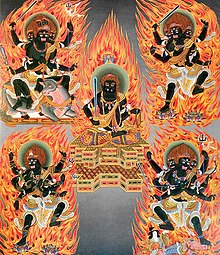Wisdom King
This article relies largely or entirely on a single source. (April 2011) |

| Part of a series on |
| Buddhism |
|---|
 |
In Vajrayana Buddhism, a Wisdom King (Sanskrit Vidyārāja, Chinese: 明王; pinyin: Míngwáng; Japanese pronunciation: Myōō) is the third type of deity after buddhas and Bodhisattvas. The Sanskrit name literally translates as "knowledge king", thus the Chinese character "明", meaning knowledgeable (and/or bright) is used, leading to wide array of alternative English names including "Radiant King", among others like "Guardian King". In Tibetan Buddhism, they are known as Herukas.
The female counterparts of Wisdom Kings are known as Wisdom Queens (Sanskrit vidyā-rājñī, Chinese: 明妃 Míngfēi, Japanese: 明妃 Myōhi), although it is ignored except the Tantrism.
Doctrine
On a general level, the Wisdom Kings are viewed as the guardians of Buddhism, and wrathful manifestations of Buddhas. In particular, the Five Wisdom Kings are the protectors of the Five Wisdom Buddhas.[1]
According to the esoteric doctrine of the Three Wheels, whereas Buddhas represent pure concepts and bodhisattvas teach through compassion, Wisdom Kings are the embodiment of the wheel of injunction and teach through fear, shocking nonbelievers into faith.[1]
Iconography

As mentioned above, Wisdom Kings are usually represented as wrathful deities, often with blue skin, multiple arms, sometimes with many faces, and even many legs. They hold weapons in their hands and are sometimes adorned with skulls, snakes or animal skins and wreathed in flames.
A notable exception is Mahamayuri (Sanskrit: महामायूरी Mahāmāyūrī, Chinese: 孔雀明王 Kǒngquè Míngwáng, Japanese: 孔雀明王 Kujaku Myōō), the "Peacock Wisdom King", who is usually presented with a peaceful expression. He is easily identifiable as he usually rides a peacock.
Mahamayuri is the primitive Wisdom King before Vajrayana Buddhism was systematized and before Wisdom Kings were differentiated for various phases. Although there is a Wisdom King who is mentioned with a flight among Wisdom Kings of after ages, as for this Mahamayuri, a flight was symbolized by a peacock. The reason why a peacock was chosen is that peacocks eat poisonous snakes.[2] As for Kuṇḍali Vidyarāja made in after ages, he is coiled around snakes.
List of Wisdom Kings
The Five Wisdom Kings
In the Shingon tradition of Esoteric Buddhism, the Five Great Wisdom Kings (五大明王; Godai Myo-o,[3] Wǔ Dà Míngwáng), also known as the Five Guardian Kings are a group of Wisdom Kings who represent the luminescent wisdom of the Buddha and protect the Five Wisdom Buddhas. The Five Kings are usually defined as follows.

- Acala (不動明王, Jp: Fudo Myo-o; Ch: Bùdòng Míngwáng) "The Immovable One" - Wrathful manifestation of Buddha Mahavairocana
- Trailokyavijaya (降三世明王, Jp: Gozanze Myo-o; Ch: Jiàngsānshì Míngwáng) "The Conqueror of The Three Planes" - Wrathful manifestation of Buddha Akshobhya
- Kuṇḍali Vidyarāja (軍荼利明王, Jp: Gundari Myo-o; Ch: Jūntúlì Míngwáng) "The Dispenser of Heavenly Nectar" - Wrathful manifestation of Buddha Ratnasambhava
- Vajrabhairava (大威德明王, Jp: Daiitoku Myo-o; Ch: Dàwēidé Míngwáng) "The Defeater of Death" - Wrathful manifestation of Buddha Amitābha[4]
- Vajrayaksa (金剛夜叉明王, Jp: Kongo-Yasha; Ch: Jīngāng Yèchā Míngwáng) "The Devourer of Demons" - Wrathful manifestation of Buddha Amoghasiddhi
The Five Wisdom Kings inhabit the Womb Realm. They are organised according to the directions of the compass.
| Vajrayaksa
(north) |
||
| Vajrabhairava
(west) |
Acala
(principal deity/ meditator) |
fr
(east) |
| Kundali
(south) |
Gallery
Others
- Ragaraja (Jp: Aizen Myō-ō)
- Hayagriva (Jp: Batou Kannon) The horse-headed wrathful manifestation of Avalokitesvara
- Mahamayuri(Jp: Kujaku Myō-ō)
- Ucchusma (Jp: Ususama Myō-ō)
See also
- Dharmapāla and Lokapāla, the Protectors in Tibetan Buddhism
References
- ^ a b Baroni, Helen Josephine (2002). The illustrated encyclopedia of Zen Buddhism. New York: Rosen Pub. Group. p. 100. ISBN 0-8239-2240-5.
- ^ Knowledge of the Buddhism: Mahamayuri. Koya-san. Retrieved 6 October 2015.
- ^ Brown, Steven T. (2001), Theatricalities of power: the cultural politics of Noh, Stanford University Press, p. 85, ISBN 0-8047-4070-4
- ^ J. Hackin (1994). Asiatic Mythology: A Detailed Description and Explanation of the Mythologies of All the Great Nations of Asia. Asian Educational Services. p. 423. ISBN 978-81-206-0920-4.
Further reading
- Mark and Luebeck,Walter Hosak (2006). Big Book of Reiki Symbols, The. Tokyo: Lotus Press. ISBN 0-914955-64-0.








